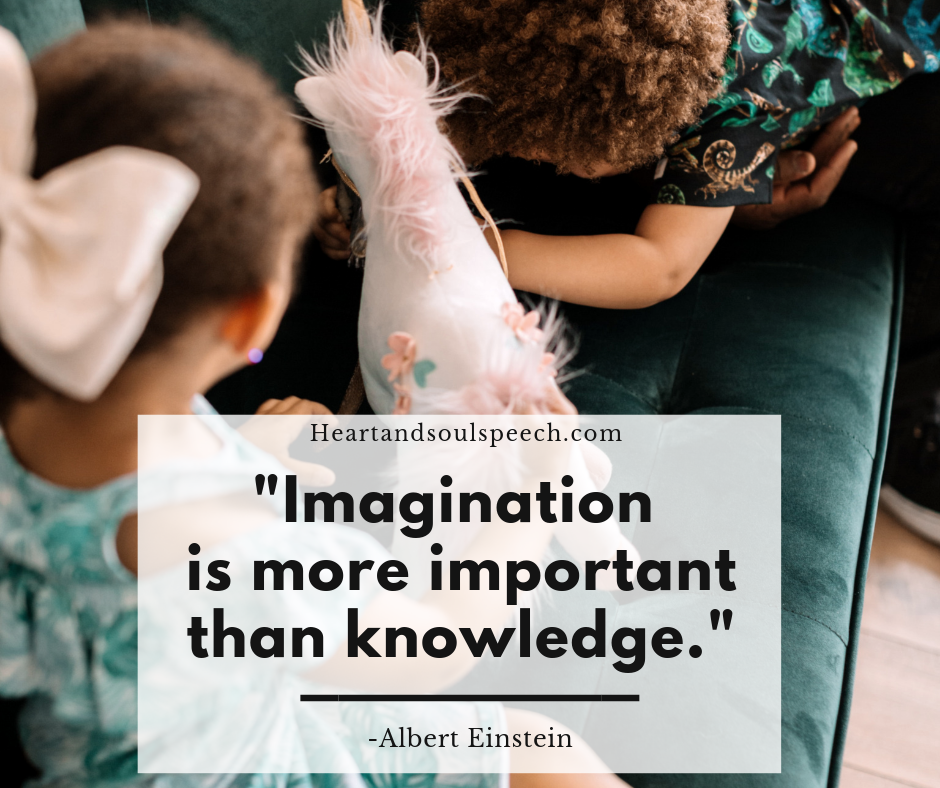
Research indicates there are several risk factors for delayed language skills, developmental delays, and cognitive delays. One of the risk factors is decreased pretend play skills. Pretend play begins to develop around 12-18 months, but isn’t mastered until 3-5 years.
What is pretend play?
Children develop pretend play skills later, after functional play and constructional play skills has started forming. (Read more about the stages of play development here.) Pretend play, or symbolic/dramatic play is when a child can use their imagination to do common everyday activities in their play. Laura Mize, SLP refers to pretend play when a child:
- Uses an object to represent another object — A child may use a fork to brush their doll’s hair or a block as a telephone.
- Gives objects properties – A child may pretend the play food is “hot” and blow on it.
- Refers to invisible objects – A child may “drive” an invisible race car.
How are pretend play and language development connected?
When a child is able to pretend, they are learning to use symbolic thinking (using an object to represent another object). We are able to understand what they are thinking. Words are symbols that represent objects, people, events, emotions, etc.
When a child isn’t able to use other objects or thoughts to represent something that’s not physically present, they do not establish the cognitive foundation for using words meaningfully. Cognition, or how a person processes information, is essential for language development.
Pretend play can also increase social skills, the ability to take other’s perspective, turn-taking, creativity, and exposure to new vocabulary. Adults use their imagination daily to solve problems, invent, visualize, understand others’ perspectives, make plans, create new ideas, and think creatively. Pretending is an important cognitive skill used throughout life.
Ways to Improve Pretend Play Skills
Teaching pretend play takes time to develop, especially for children with language delays and/or cognitive delays. It may take months, so be patient and keep playing!
Begin by helping a child learn to use everyday objects from daily routines “on” themselves as expected. For example, have the child put their hat on their own head or pretend to brush their hair with a brush. Then, help the child learn to use the everyday objects on another person. The child would now put their hat on Daddy’s head or brush Mommy’s hair. Finally, help the child use the everyday objects with another toy. The child will now put their hat on Teddy bear’s head or brush their doll’s hair.
-
Introduce open-ended toys (more than one way to play with the toy).
Examples: Blocks, toy cars, dolls, stuffed animals, pretend food, puppets, playdough, dress up costumes
Read more about specific pretend play ideas with these toys here.
-
Play face-to-face with your child.
Be on the floor or eye-level when you play. Your child can see and imitate your face, gestures, and actions more easily.
-
Follow your child’s lead.
Observe your child and then imitate their actions. If the child is pushing the truck without purpose, do the same. After a few turns, pretend to drive the truck over a block bridge or crash it into another toy. Try it and then wait to see if your child imitates you.
-
Model pretend play for your child.
If your child isn’t pretending yet, try modeling one pretend action with a toy and wait to see if they imitate you. For example, you can pick up a toy food and pretend to eat it, saying “mmm, yummy!” Then set the food down in front of them and see if they repeat it.
-
Keep it simple.
Pretend play doesn’t have to be elaborate. Only introduce a small number of toys/role play at a time. It may be enough to “feed” the doll with a bottle, not pretending to fill it up, feed baby, and then burp baby. Remember to take turns with your child and not bombard them with too many expectations or talking.
If you have concerns with your child’s play development, please refer to a pediatric speech-language pathologist or Contact Us. Early intervention is crucial for a child who may be at risk for language delays.
This is Part 4 of our Play Series. Click the links to read Part 1: Why is Play Important? Part 2:Stages of Play Development Part 3: Independent Play

3 Responses